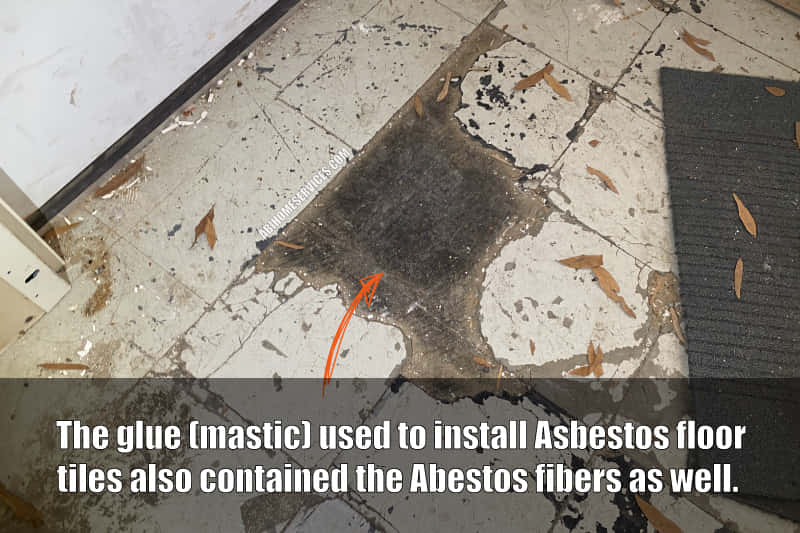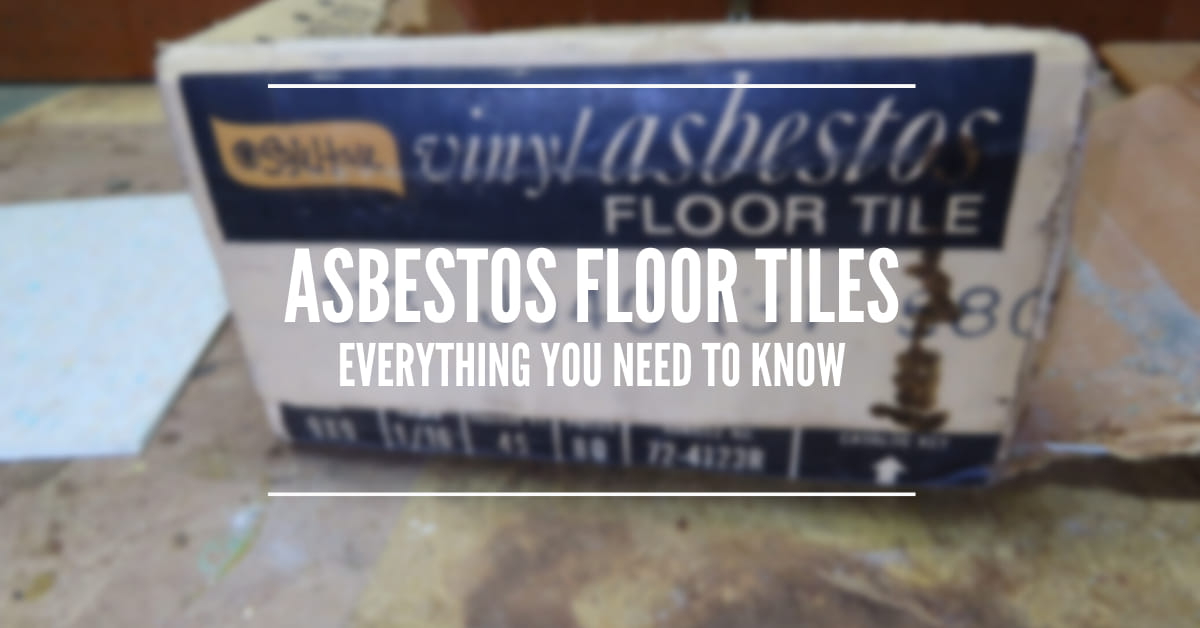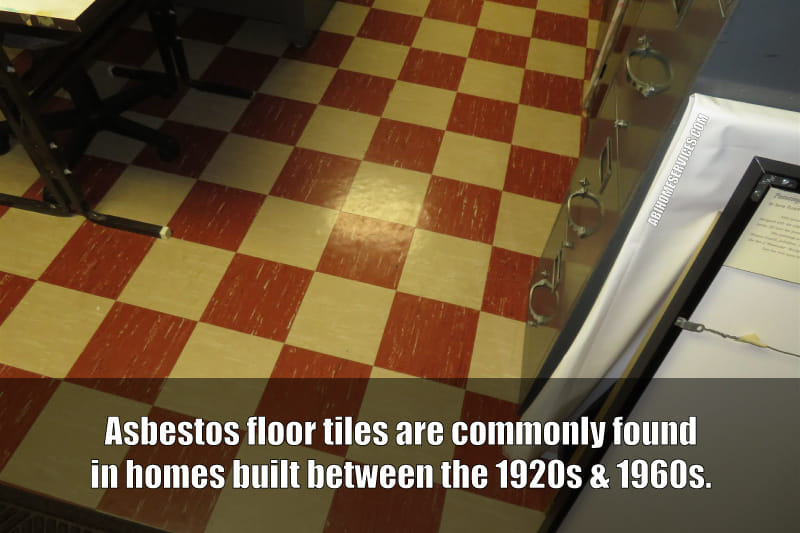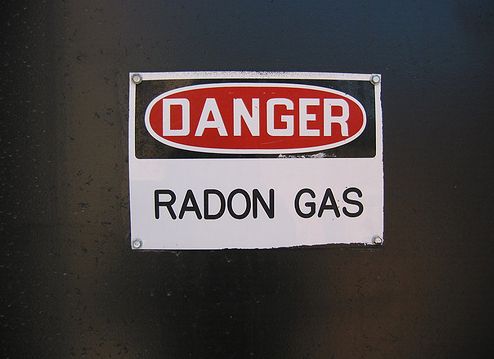Asbestos Floor Tiles
The subject of Asbestos, the types of materials can contain Asbestos, and what type of danger my clients may be in, should they buy a house with Asbestos products in, it inevitably comes up in the conversation when I’m performing a home inspection in an older home.
Louisville, KY is packed with old houses, and Asbestos floor tiles are one of the most common materials I find in these homes, specifically in the neighborhoods of the Highlands, Old Louisville, Cherokee Triangle, Hikes Point, and Germantown.
During my Tour of Waverly Hills Sanatorium I noticed that most old the old patients rooms still have the insert where the old Asbestos floor tiles were installed. These floor tiles were used an accent piece in flooring.
Let’s take a deep dive into Asbestos floor tiles, and what you as a home buyer/homeowner need to understand if you are buying a home that has asbestos floor tiles installed.
What is Asbestos?
Asbestos is a strong, fire-resistant mineral that, at one time, was added to the recipe of many products to make them stronger, more resilient, and last longer overall. Over the years, Asbestos has been used in thousands of products, and we’re not talking about just floor tiles and plaster. Asbestos was used in brake pads, hairdryers, and many, many items.
It wasn’t until the 1970s and 1980s that regulations were put into place to stop the use of the mineral in many products and to heavily regulate its use in the products still using it. These changes came about because of the newly discovered health issues that can result from exposure to Asbestos.
‘Wikipedia has Asbestos listed as a naturally occurring fibrous silicate mineral. There are six types, all of which are composed of long and thin fibrous crystals, each fibre being composed of many microscopic “fibrils” that can be released into the atmosphere by abrasion and other processes. Inhalation of asbestos fibres can lead to various serious lung conditions, including mesothelioma, asbestosis, and lung cancer, so it is now notorious as a health and safety hazard.‘
Asbestos use dates back over 4,500 years. (It has been found in pottery and cooking utensils.) So to say that it has been used throughout human society for a long time would be an understatement.
In this post, we will focus our attention on one product: Asbestos Floor Tiles.
When Were Asbestos Floor Tiles Used?
Asbestos floor tiles were first installed in the early 1920s and were commonly used until the late 1960s. I have read that some places still installed Asbestos floor tiles into the early 1980s, but I can’t recall ever seeing them in a house that new.
If you own a home (or are thinking about buying a home) built between the 1920s and 1960s, there is a very good chance Asbestos floor tiles are present somewhere in the house.
I’ve seen the tiles installed in just about every room. However, I typically see them in basements, or throughout the entire home in concrete slab houses built in the 1940s,1950s, and 1960s.
Sometimes I find the tiles under carpet that was laid at a later time. They are not always visible; sometimes you have to hunt for them.
How to Identify Asbestos Floor Tiles
To know for sure if the floor tiles in your home contain Asbestos, you will need to have them tested. You can take a small sample to a testing lab, or you can order your own DIY Asbestos Test Kit.
It is always best practice to assume the floor tiles in older homes contain Asbestos until you have had them tested.
It is probably a safe bet that any floor tile installed after the early 1980s was not made with Asbestos. However, it’s possible that a contractor used ‘new old stock’ to clean out his warehouse on your home in 1987. In other words, don’t assume anything.
Asbestos floor tiles came in multiple sizes and colors. The sizes were 9×9, 12×12, and 18×18. While many homes have the 12″ and 18″ tiles installed, by far the most common is the 9×9 size. Note: I have read that 6×6 tiles were made as well, but I have never seen them in the wild. If you have a picture of them please send them my way and I’ll add it to this post.
In the home inspection world, it’s common practice to tell clients to assume that the vinyl floor tiles installed in their home are likely to contain Asbestos, and not to do anything (like trying to remove the tiles) until the proper testing can take place to deem them safe.
When dealing with Asbestos vinyl floor tiles, it’s very much a “guilty until proven innocent“ situation.
Every once in a while we get lucky and find an old box of floor tiles socked away in the house. In cases like these, it’s safe to say that the tiles DO contain Asbestos.
How do I know? It’s printed on the box.
Unfortunately, not every manufacturer printed the word Asbestos on the packaging, so you can’t always tell if the floor tiles contain Asbestos by looking at an old box.

Can You Live With Asbestos Floor Tiles?
Let’s assume you buy a house that has Asbestos floor tiles. Let’s then assume that you have the floor tiles tested, and the results show that they do contain Asbestos. Now what?
At this point, you have two options.
- Live with the tiles, and understand the health risks that may come with that decision.
- Have the Asbestos floor tiles removed to minimize your risk.
My buyers all ask the same question when we come across these old floor tiles and don’t have definitive proof that they contain Asbestos.
Is it safe to live with them? The answer is: maybe.
Asbestos products are sorted into two categories. Friable and Non-Friable.
What does friable mean? The Merriam-Webster dictionary says “easily crumbled or pulverized.”
When it comes to Asbestos vinyl floor tiles, they get lumped into the friable category if they are crumbling or damaged and non-friable if they are in good condition and are not falling apart.
Just about any product that was made with Asbestos has little to no risk to you if it’s in good condition, or not friable, and is not being tampered with.
Things change when people try to improperly remove the Asbestos floor tiles from their homes by not taking the correct steps. You can read more about the EPA guidelines for that process here.
In other words, if your floor tiles are still in good shape, as a lot of them are, your best option is to leave them in place and not try to remove them. The good news is that because they are only 1/16″ thick, you can easily cover them with just about any modern flooring choice and you will not be able to tell that they are hiding under the surface.
If your Asbestos floor tiles are popping up, falling apart, and have become friable, you will want to take the proper steps to have them removed for your safety. Then you can install your new flooring with little to no risk.
NOTE: I have been told that most of the big box stores like Lowe’s, Home Depot, and Menards will not install their products in a home that contains possible Asbestos tiles. If you have the suspect tiles installed in your home, be sure and ask if this will be an issue with your new floor.
How to Safely Remove Asbestos Floor Tiles
I want to make myself very clear: Most of you do not have the tools, skills, or knowledge to safely remove Asbestos floor tiles on your own. This task is not something you want to flex your DIY muscles on.
Removal of Asbestos tiles is one of those situations where it’s best to leave things to the professionals. It’s not worth the risk.
If you still think you can tackle this job (again, you probably can’t) be sure you check your local and state regulations to see what rules may be in place. Some municipalities do not allow homeowners to perform their own abatement on Asbestos materials. Kentucky does not have such a statewide law, although there may be a local rule in parts of the state where the regulations are different.
With all of that said, if you still want to try and remove your own Asbestos floor tiles you need to make sure that you do the following:
- Seal off your work area with sheets of plastic. This plastic should be taped at all of the seams and should have no holes or tears.
- Tape off all windows, doors, and HVAC vents. Shut down your HVAC system as well. The last thing you want to do is containimate your whole home by sucking in the Asbestos fibers and blowing it out in every room of your house.
- Wear a full face respirator with the proper filters. Be sure you double check that the respirator is rated for the type of application that you need. No, an N95 mask is not acceptable for this level of work. Also, if you have a beard, shave it so that your respirator will seal against your face. Be certain you also follow the proper seal test for your equipment.
- Set up a HEPA air scrubber inside the work area to keep contanimation down. If the area is large, you may need more than one of these units. These are not like the air purifier in your bedroom. You’re looking for something more like this HEPA Air Scrubber.
- Asbestos fibers are tiny and hard to wash out of clothes, so you’ll want to wear a dispoable suit with booties and gloves. We’re talking full-on hazmat level protection here.
- Get a pump sprayer full of water to saturate the tiles. The water keeps the dust down and helps prevent a cloud of Asbestos from forming inside your work area.
- Have a HEPA vacuum available to clean all tools and work area after the job is done.
- Acquire sealable plastic bags to put your freshly removed Asbestos tiles in. You should not try to throw away these tiles in your weekly trash. There are special bags that should be used, and you’ll need to find a landfill that will accept Asbestos. Be prepared to be shocked at the dump fee for such a place.
If you still think you can handle removing your own Asbestos floor tiles after reading and understanding that list, Godspeed. In my book, it’s much easier to simply install a new layer of flooring over the old tiles or write a check and let a pro handle it.
Note: The state of Kentucky (Kentucky Energy and Environment Cabinet) does not regulate the removal of Asbestos from most buildings. You’ll want to check your local laws to make sure you don’t create a problem for yourself by trying to remove your own Asbestos tiles. Here is the excerpt from the State of Kentucky website:
Asbestos removal and disposal from single-family homes or apartments of four or less units is not regulated under Kentucky law. Nevertheless, it is advisable to seek help from a certified asbestos abatement contractor when removing asbestos material that may crumble. Certified professionals are trained to safely remove asbestos materials to minimize the release of asbestos fibers into the air you breathe.
What Is Black Mastic Asbestos, aka Cutback Adhesive?
Old vinyl floor tiles are not the only materials that can contain Asbestos. A lot of the mastic (glue) used to install the tiles to the floor/subfloor also contained Asbestos.
Mastic is the back glue/coating you see on the floor once the tiles have been removed. It’s also known as Cutback Adhesive. Cutback Adhesive is asphalt-based and is not water-soluble.
You can’t scrub this adhesive off the floor. In fact, trying to remove this black layer may create contamination of the home if the proper safety protocols are not followed. A lot of this glue was made with Asbestos, and if you try to remove it without setting up the proper bubble we talked about above, you will contaminate the entire house.
Leaving an exposed layer of Cutback Adhesive in your home is not a viable option either. Doing so could create a friable Asbestos situation by means of foot traffic on the floor. And that’s not good.
There are encapsulation products available that claim you can paint over the Cutback Adhesive and make it ‘safe’. Be sure to do your own research before trying these products.

Health Risk in Dealing With Asbestos
Living and working around friable Asbestos can be dangerous if you do not take the proper steps to protect yourself. The health risk of being exposed to friable Asbestos includes a slew of respiratory issues such as Asbestosis, Pleural disease, Lung cancer, and Mesothelioma.
Essentially, the fibers of Asbestos are so small we can’t see them. If we are exposed to friable Asbestos, we breathe in these tiny fibers and they get stuck in our lungs. These foreign objects can create scar tissue inside our lungs and everything goes downhill from there. If you are exposed to enough Abestos fibers, it will not end well.
How much exposure is too much? I don’t know. I know this will surprise you, but I’m not a doctor.
The smart move would be to remove as many Asbestos fibers from your life as you can. Don’t try and create this false threshold of “safe” risk in your mind to save a few bucks in abatement costs. Your body and your health do not care how much it costs.
Conclusion
You should have a good grasp on all things Asbestos floor tiles at this point. The key takeaways should be:
- All floor tiles that are suspected to contain Asbestos should be tested to check for Asbestos fibers.
- All suspect floor tiles should be deemed positive for Asbstos until proven otherwise.
- Removal of Asbestos floor tiles is not a difficult job, but it is one that must be done following the proper steps to ensure safety.
- Installing a new layer of flooring over old Asbestos tile is generally a great option for most homes.
- The black mastic that was used to install Asbestos tiles can also contain Asbestos fibers.
Frequently Asked Questions
Here are some other links with helpful information on Asbestos materials and the health issues that can come from being exposed.
Asbestos: Not Just Insulation
Kentucky State Website on Asbestos










Did sheet vinyl flooring have asbestos such as a 12 foot by 12 foot sheet of vinyl like that used in the kitchen in the 1960s?
Not to my knowledge, David. I have never read or seen anything about rolled flooring having Asbestos. If you are worried about it you could have it tested just to be on the safe side.